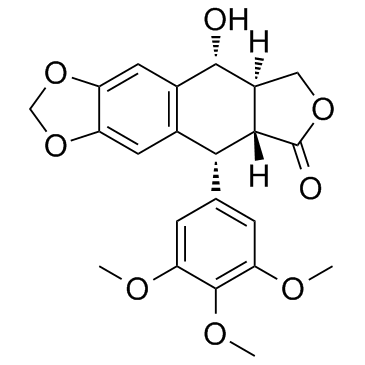Podophyllotoxin

Podophyllotoxin structure
|
Common Name | Podophyllotoxin | ||
|---|---|---|---|---|
| CAS Number | 518-28-5 | Molecular Weight | 414.405 | |
| Density | 1.4±0.1 g/cm3 | Boiling Point | 597.9±50.0 °C at 760 mmHg | |
| Molecular Formula | C22H22O8 | Melting Point | 183-184 °C(lit.) | |
| MSDS | Chinese USA | Flash Point | 210.2±23.6 °C | |
| Symbol |

GHS06 |
Signal Word | Danger | |
|
Cheminformatics analysis of assertions mined from literature that describe drug-induced liver injury in different species.
Chem. Res. Toxicol. 23 , 171-83, (2010) Drug-induced liver injury is one of the main causes of drug attrition. The ability to predict the liver effects of drug candidates from their chemical structures is critical to help guide experimental drug discovery projects toward safer medicines. In this st... |
|
|
Translating clinical findings into knowledge in drug safety evaluation--drug induced liver injury prediction system (DILIps).
J. Sci. Ind. Res. 65(10) , 808, (2006) Drug-induced liver injury (DILI) is a significant concern in drug development due to the poor concordance between preclinical and clinical findings of liver toxicity. We hypothesized that the DILI types (hepatotoxic side effects) seen in the clinic can be tra... |
|
|
Chemical genetics reveals a complex functional ground state of neural stem cells.
Nat. Chem. Biol. 3(5) , 268-273, (2007) The identification of self-renewing and multipotent neural stem cells (NSCs) in the mammalian brain holds promise for the treatment of neurological diseases and has yielded new insight into brain cancer. However, the complete repertoire of signaling pathways ... |
|
|
Genetic mapping of targets mediating differential chemical phenotypes in Plasmodium falciparum.
Nat. Chem. Biol. 5 , 765-71, (2009) Studies of gene function and molecular mechanisms in Plasmodium falciparum are hampered by difficulties in characterizing and measuring phenotypic differences between individual parasites. We screened seven parasite lines for differences in responses to 1,279... |
|
|
Anti-Helicobacter pylori, gastroprotective, anti-inflammatory, and cytotoxic activities of methanolic extracts of five different populations of Hippocratea celastroides collected in Mexico.
J. Ethnopharmacol. 155(2) , 1156-63, (2014) The root barks of Hippocratea celastroides have been used for decades in Mexican traditional medicine to treat gastritis and ulcers. To investigate the anti-Helicobacter pylori, gastroprotective, anti-inflammatory, and cytotoxic activities of methanolic extra... |
|
|
Aryl hydantoin Ro 13-3978, a broad-spectrum antischistosomal.
J. Antimicrob. Chemother. 70 , 1788-97, (2015) Praziquantel is the only drug available for the treatment of schistosomiasis and the state of the exhausted drug discovery pipeline is alarming. We restarted investigations on the abandoned antischistosomal Ro 13-3978, an aryl hydantoin discovered in the earl... |
|
|
Antimalarial dual drugs based on potent inhibitors of glutathione reductase from Plasmodium falciparum.
J. Med. Chem. 51 , 1260-77, (2008) Plasmodium parasites are exposed to higher fluxes of reactive oxygen species and need high activities of intracellular antioxidant systems providing a steady glutathione flux. As a future generation of dual drugs, 18 naphthoquinones and phenols (or their redu... |
|
|
Antiplasmodial and anti-inflammatory effects of an antimalarial remedy from the Wayana Amerindians, French Guiana: takamalaimë (Psidium acutangulum Mart. ex DC., Myrtaceae).
J. Ethnopharmacol. 166 , 279-85, (2015) Field investigations highlighted the use of Psidium acutangulum Mart. ex DC (syn. P. persoonii McVaugh), a small tree used by the Wayana Amerindians in Twenke-Taluhwen and Antecume-Pata, French Guiana, for the treatment of malaria, and administered either ora... |
|
|
A highly tumor-targeted nanoparticle of podophyllotoxin penetrated tumor core and regressed multidrug resistant tumors.
Biomaterials 52 , 335-46, (2015) Podophyllotoxin (PPT) exhibited significant activity against P-glycoprotein mediated multidrug resistant (MDR) tumor cell lines; however, due to its poor solubility and high toxicity, PPT cannot be dosed systemically, preventing its clinical use for MDR cance... |
|
|
Marine natural products from the Turkish sponge Agelas oroides that inhibit the enoyl reductases from Plasmodium falciparum, Mycobacterium tuberculosis and Escherichia coli.
Bioorg. Med. Chem. 15 , 6834-45, (2007) The type II fatty acid pathway (FAS-II) is a validated target for antimicrobial drug discovery. An activity-guided isolation procedure based on Plasmodium falciparum enoyl-ACP reductase (PfFabI) enzyme inhibition assay on the n-hexane-, the CHCl(3-) and the a... |